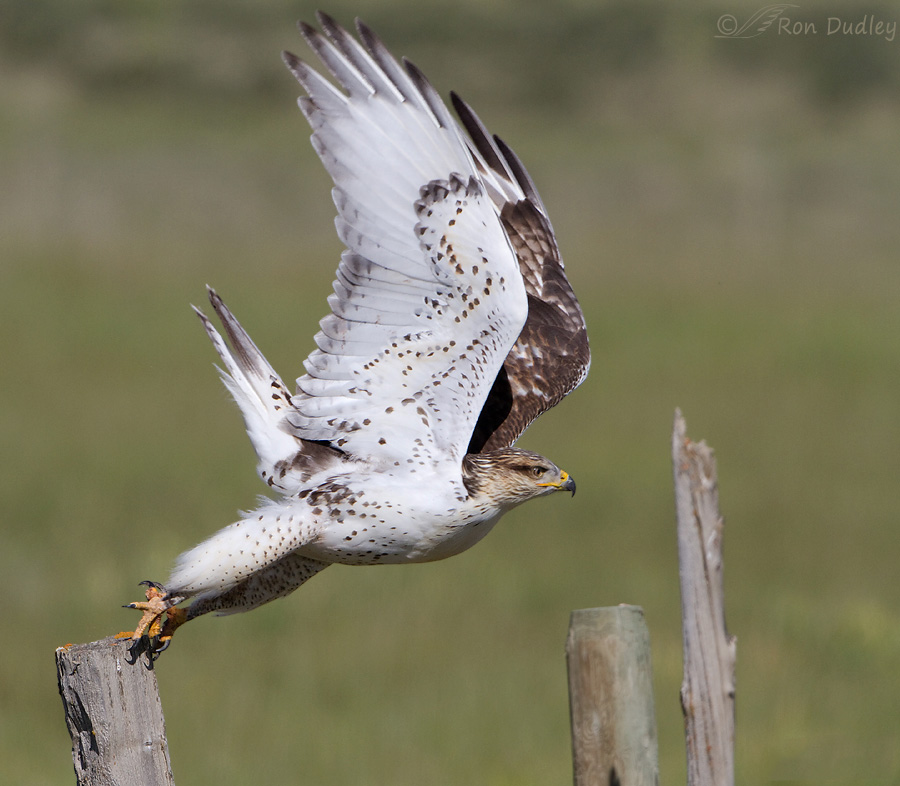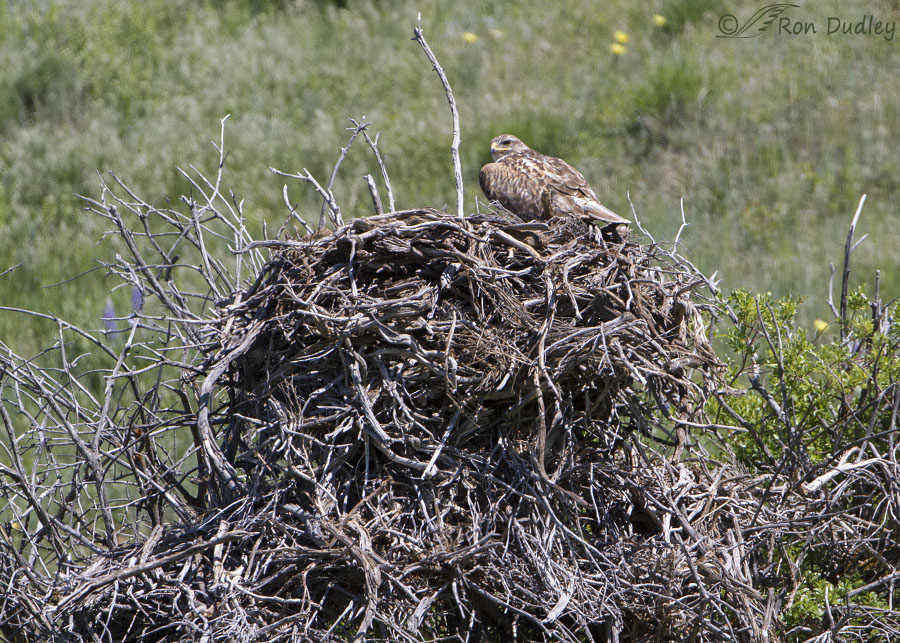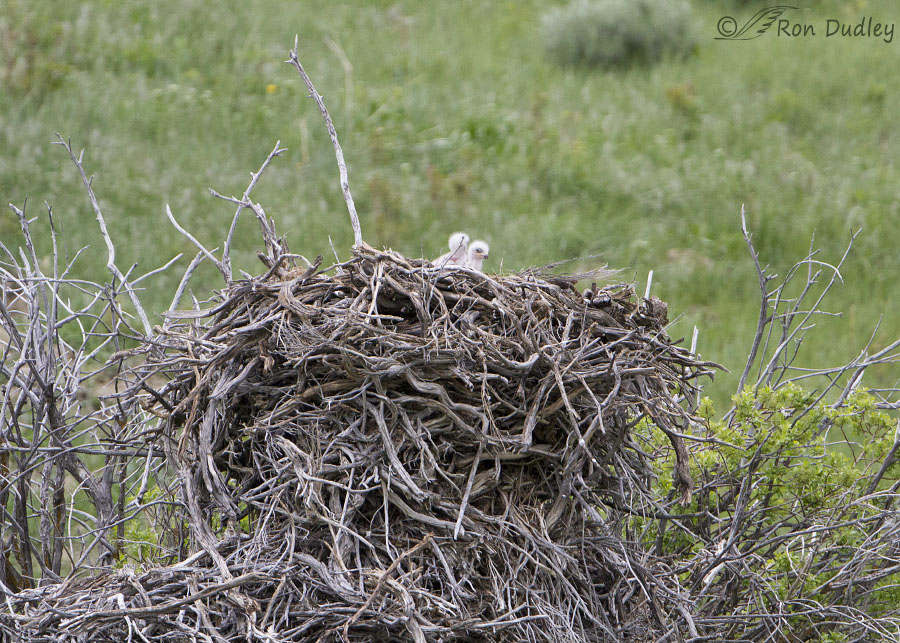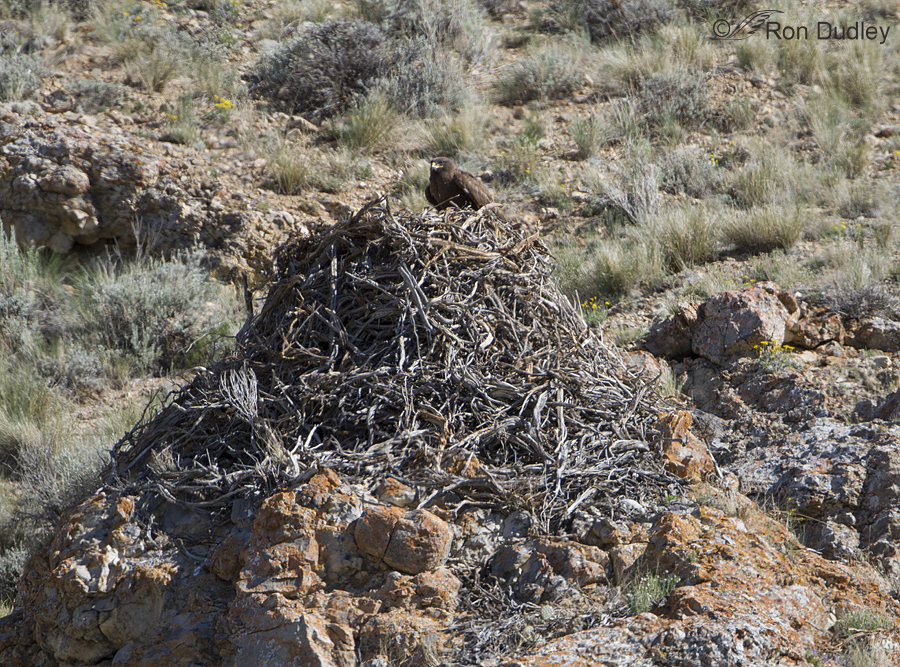And both of them were in or very near Montana’s Centennial Valley. I’ll bet some of my readers already know what species constructed them.

Yup, they were Ferruginous Hawk nests. First a look at the species responsible for such impressive nest construction.
They’re the largest buteo in North America. Just look how deep-chested and robust this one is, even stretched out like this. The renowned ornithologist Arthur Cleveland Bent described them as a “splendid hawk, the largest, most powerful, and grandest of our buteos, a truly regal bird”. Those intimately familiar with them often compare them to Golden Eagles. Both species have feathered tarsi, build huge nests, lay eggs that are quite similar and their voice, flight, behavior and food habits are much alike.
Believe me, this is one impressive hawk.

I’ve followed both of these nests for several years and they’re absolutely huge. They sometimes build on top of an old nest and this one must have been used for generations. Some of these branches are very large and historically this species often used bison bones in their nest construction when they were available (pronghorn bones too). Because of the placement of the nest against the side of a mountain I could never get anything but sidelight on it for my photos and that made for some pretty contrasty images but… you get the picture.
This is a very large bird but the nest still looks huge by comparison. Yes, I know I’m overusing that ‘huge’ word but no other one seems to do the situation justice.

Here’s the same nest 10 days earlier – photo taken from a much different angle, at a different time of day and in more subdued light. They apparently made a lot of modifications to the nest in those 10 days, both up top and to the sides, because you have to look carefully to tell it’s the same nest. I suspect those fierce Montana winds have made a difference too. There were actually three chicks in the nest but this shot shows only two of them.

Here’s another Ferruginous Hawk nest perhaps 5-6 miles west of the previous one and just outside the confines of the valley.
This one is occupied by a dark morph Ferrug and it’s a very large nest also. The previous nest was built at the base of a partially-dead large shrub but this one was built directly on the rocks on the side of a small mountain. Before the settling of the west this species often nested on elevated ground but in modern times they’re more likely to nest in trees or shrubs.
Over the years I’ve seen a good number of Ferruginous Hawk nests. Many of them were in Montana in either the southwest or northwest parts of the state and these two were the largest of the bunch. Even considering their large size the species builds an unusually massive nest because they often reuse nests for many years and as many as five large chicks must be able to lie flat in them when strong winds blow.
Ron
Note: Ferruginous Hawks are unusually sensitive to nest encroachment by humans and it goes without saying that I never approached these nests closely. I always stayed inside my pickup on the road and I was photographing them at an effective 1120mm.


Ron, that taking off photo is spectacular. I believe we occasionally have Ferruginous Hawks in this area, but I have never seen one, nor have I ever seen nests like these. Remarkable structures. Wonder if a Nat Geo film crew has ever done a video of them building one of those? Hope to see one here one of these days.
Everett Sanborn, Prescott AZ
Amazing! Thanks for sharing.
Charlotte
Love the majesty of the first shot! And pantaloons! And little fuzz-butts in the nest! How’s “gargantuan” for a nest descriptor? Count me in the group that had no idea they used bones as building materials.
How’s “gargantuan” for a nest descriptor? Count me in the group that had no idea they used bones as building materials.
Yup, gargantuan works for me, Marty. Thank you.
Mammoth would also work. And without question they would use mammoth bones if they were available.
Britches!!!! I haven’t seen bird britches in an age.
And goodness the chicks look tiny in that McMansion of a nest.
GMTA yet again!
I figured you might appreciate them, EC…
Yeah, don’t you just love them britches? LOL!! I’m so easily amused. Just a bunch of feathers, arranged correctly, gets me every time. Oh and yes the bird underneath those feathers, too!
We have a eagle nest on a butte in town, each year it is bigger. We have learned that the eagles fill in the nest, the reason we guess is so that new born are on “clean” bedding. In order to keep the depth they wish they fill up the sides, so what you see of the tree is less each year.
Interesting, Steven.
What beautiful underwings. It look like those nests, especially the first one, would be difficult for a ground dwelling predator to ascend. Really impressive photos and story.
Thank you, Lyle.
Both nest and bird are impressive…first image is a beautiful demonstration of one of my favorite birds in one of my favorite pose…what I call the “fling” position, with both wings flung up for the downstroke power lift…wonderful, wonderful images!!!
Thanks very much, Patty.
What massive nests (there’s another word for huge…LOL!)! I would guess that those nests have cradled baby Ferrugs for a LOT of years–decades if not centuries. And I never knew that they used to use bison bones. Just WOW! The encroachment of (white) humans/settlers must have hit them hard with the massacre of bison in the 19th Century. It’s not like there’s a LOT of other construction materials. Small feet comment aside, those small feet deliver quite a crush factor. They’re small but mighty.
Small feet comment aside, those small feet deliver quite a crush factor. They’re small but mighty.
Ferrugs are splendidly gorgeous buteos, despite their smallish feet (for their size), but I’m in the camp that they SHOULD be categorized with eagles. Yeah, I know, but remember, I’m NOT an -ologist of any kind, nor do I play one on TV
I love the dark morph (and there’s a surprise for you!)! Alas, I’d have probably IDed that one as a golden, at least at first. FAIL! I would hope that I might have noticed the lack of the golden nape plus that huge gape. But maybe not. Sigh! But I’m a fool for the dark morphs.
It does resemble a golden at first glance, Laura – until you notice the two things you mentioned. As far as I could tell that bird was completely dark but it wasn’t very close.
And you’re right about their relatively small but very powerful feet.
“Believe me this is one impressive bird”. I couldn’t find better words than yours.
As other readers have commented, you’d think that the little chicks would get lost in the nest.
Ron, thanks for the photos and the lesson. You are still a great teacher.
Thank you, Alice – especially for the teacher remark.
My daughters favorite bird. She too has often stated they need to be in the eagle family not hawk. The dark morph is one of the darkest I have seen, great find. Driving the back roads to return from St George we saw a few ferrugies on poles. I always get excited, my husband moans and claims he did not see anything that I am making it up. I think it would have to bite him in the ass in order for him to notice it!
That dark morph was a spectacular bird! Your last sentence made me smile, April.
Bones? That’s crazy. I am always learning from you, professor!
I agree, it’s hard to imagine isn’t it!
Very interesting. The massive size of these nests reminds me of the Magpie nests you’ve photographed. Proportionate to the size of the bird they also seem to be huge.
Yes, that one magpie nest I’ve posted here is a large one, Susan – especially considering the size of magpies.
Beautiful birds and wonderful photos. Can’t wait to get out West to see these awesome creatures someday!
I hope you can make it out here, Joanne. Thanks.
Great shots of the nests! The only really interesting nest I saw (Which was years ago) was a family of Ospreys that decided to nest on a Universal billboard in Florida. The size of that nest pales in comparison to these though!
Yes, Ospreys build good sized nests but nowhere near this size. Thanks, Xavier.
Simply put…incredible! The intricacies of weaving that goes on to construct a massive nest like this and have it remain for years easily could be called artistry. A beautiful hawk which we do not see here in Wisconsin. No wonder it is ‘Buteo regalis’.
Agreed, Kathy. That scientific name is perfect for them.
WOW! Knew eagles built huge nests, but not hawks! Looks like the little chicks could almost get lost in them! Would not have thought about the wind being a big issue for the chicks – always something to learn. I’ve never seen huge nests like that on rocks – mainly in old dead cottonwood trees – have to be REALLY tough birds to haul some of those “logs” to the next and place them!
Would not have thought about the wind being a big issue for the chicks – always something to learn. I’ve never seen huge nests like that on rocks – mainly in old dead cottonwood trees – have to be REALLY tough birds to haul some of those “logs” to the next and place them!
“have to be REALLY tough birds to haul some of those “logs” to the next and place them”
Well said, Judy. Bison bones, can you imagine!